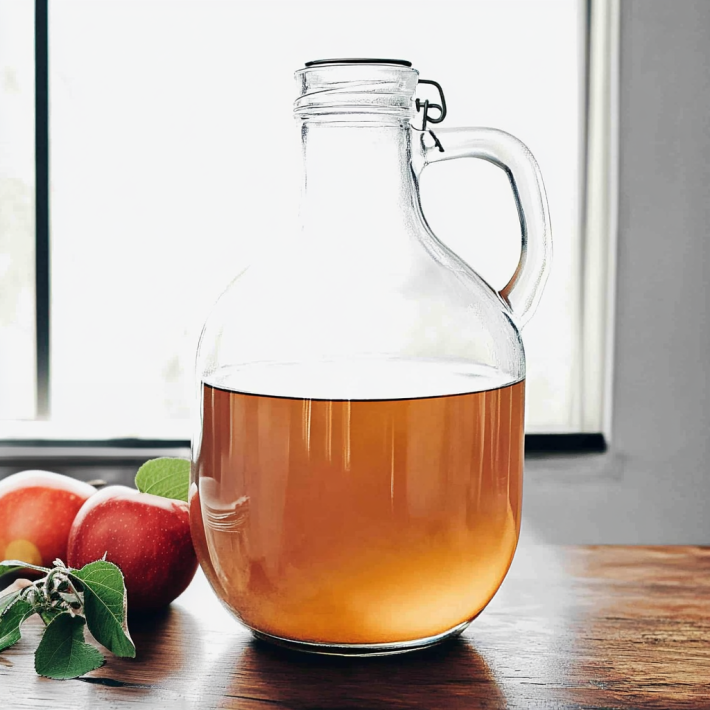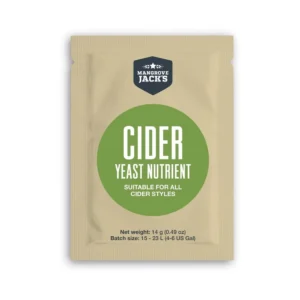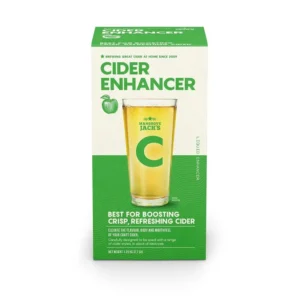Making Hard Apple Cider with Fresh Australian Apples

Making Hard Apple Cider Introduction
Making hard apple cider at home with fresh Australian apples is a fun and down-to-earth experience. Whether you’re trying something new or keen to get stuck into a project, turning local apples into a refreshing cider is easier than you think and a great way to enjoy the fruits of your labour. This guide will walk you through every step, from picking the right apples and gathering your gear, to fermenting the cider in a 5-litre glass carboy.
Plus, cider isn’t just about good times—it comes with a few health benefits too. Apples are packed with polyphenols, known for their antioxidant properties that can help reduce inflammation and support heart health. So, while you’re making a top-notch drink, you’re also giving yourself a little boost. Ready to get cracking? Let’s dive in!
Why Use Fresh Australian Apples?
Australia is home to a variety of apples that thrive in the country’s ideal climate, from tart Granny Smiths to sweet Pink Lady apples. Using fresh apples gives your cider a natural complexity and depth of flavour that you won’t get from store-bought juice. Additionally, making cider from fresh apples ensures you have full control over the ingredients, eliminating any concerns about preservatives or additives.
How Many Apples Do You Need?
For a 5-litre batch of cider, you’ll need around 8 to 10 kilograms of fresh apples. Why so many? The juice yield from apples is typically around 50-60%, meaning that about half of the weight of the apples translates into juice. For example, pressing 1 kilogram of apples will give you approximately 500-600 millilitres of juice, depending on the variety and juiciness of the apples. This means to fill a 5-litre carboy with juice, you’ll need around 8 to 10 kilograms of apples. Different apple varieties yield different amounts of juice, so the total amount may vary slightly depending on the apples you choose.
If you don’t have access to fresh Aussie apples, no worries! You can still make fantastic hard cider using high-quality cider extracts. These extracts offer a convenient way to craft delicious cider without the need for fresh fruit. Simply head over to Cider Making Kit – Complete Guide to Make Cider from Extract, which includes everything you need to get started. It’s a great alternative that ensures you still enjoy a refreshing, homemade cider with minimal effort!

Ingredients for Making Hard Cider
Essential Ingredients
Fresh Apple Juice
The most important ingredient is high-quality apple juice. With fresh apples and a juicer or another kitchen appliance, you’ll extract the juice at home. You’ll need approximately 8 to 10 kilograms of fresh apples to make 5 litres of juice, which is perfect for filling a 5-litre glass carboy. Choose a mix of sweet and tart apples to achieve a more complex and balanced flavour in your cider.
Australian Apple Varieties Perfect for Cider
Australia is home to a fantastic range of apple varieties, many of which are ideal for making cider. Whether you’re after a crisp, dry cider or something with a touch of sweetness, choosing the right blend of apples can make all the difference. Some of the top Aussie varieties to consider include:
Granny Smith: Known for their tartness and sharp flavour, Granny Smith apples are perfect for creating a crisp, dry cider with a refreshing bite. These green beauties are widely available and a staple in Aussie cider making.
Pink Lady: If you’re after a sweeter, more complex cider, Pink Lady apples bring a lovely balance of sweetness and acidity. Their natural sugar content adds a rich, fruity depth to the cider.
Fuji: Fuji apples, with their mild sweetness, are excellent for creating a smooth, easy-drinking cider. They work well when blended with tarter varieties for a well-rounded flavour.
Jonathan: This variety offers a nice balance between sweet and tart, making it a versatile option for cider. Jonathan apples bring a bit of both worlds and are perfect for those looking for a balanced cider profile.
By blending different varieties like Granny Smith for tartness and Pink Lady for sweetness, you can craft a cider that’s uniquely yours, showcasing the best of Australian apples.

Yeast
Yeast is essential for transforming the sugars in your apple juice into alcohol, and choosing the right strain can have a significant impact on the flavour and characteristics of your cider. Here’s a summary of the key cider yeast options adjusted for a 5-litre batch using 1 full satchel:
| Yeast | Description | Best For | Dosage for 5L Batch |
|---|---|---|---|
| SafCider 5g | A versatile yeast suitable for a variety of cider styles. | General cider styles | 1 satchel |
| SafCider Crisp 5g | Produces a clean, crisp cider with a refreshing finish. | Crisp, dry ciders | 1 satchel |
| SafCider Tutti Fruitti 5g | Adds a fruity, sweet character to your cider. | Fruity and sweeter ciders | 1 satchel |
| SafCider Sweet 5g | Perfect for making sweet ciders with balanced flavours. | Sweet, dessert-style ciders | 1 satchel |
| Mangrove Jack’s Cider Yeast M02 | A high ester-producing strain that enhances fruit flavours, making crisp ciders. | All cider types; complex flavours | 1 satchel |
| EC-1118 | A popular yeast known for its clean, neutral flavour, ideal for sparkling ciders. | Sparkling ciders | 1 satchel |
For a 5-litre batch, using 1 satchel of yeast will ensure a healthy fermentation and the development of desired flavours in your cider.
These yeast strains offer a variety of characteristics that can cater to different cider styles, whether you prefer something crisp, fruity, or sweet. All yeast options from Aussie Brewmakers are designed for easy use and consistent results, ensuring a successful fermentation process. Be sure to store your yeast in a cool, dry place and check the expiration date before use to guarantee optimal performance.
Other Additives and Enhancers for Cider Making Kit
- Cider Enhancer: Want to take your cider to the next level? By simply swapping out dextrose for cider enhancer in your regular cider recipe, you’ll achieve a far superior end result. This enhancer includes fermentable and non-fermentable sugars, giving your cider a fuller body, better flavor, and a more balanced mouthfeel.
- Dextrose or Lactose: Used for carbonation and sweetness adjustments. If you prefer your cider on the sweeter side, back-sweetening is required.
- Cider Yeast Nutrient: Although not absolutely required, yeast nutrient can be beneficial for promoting a healthy fermentation. Apple juice on its own lacks some of the essential nutrients that yeast need to thrive. By adding a small amount of yeast nutrient, you can help prevent issues like stuck fermentations and unwanted off-flavors, ensuring a smoother brewing process.
Equipment for Making Hard Apple Cider
- 5-Litre Glass Carboy The carboy is your fermenting vessel. Its narrow neck helps limit the juice’s exposure to oxygen, preventing oxidation during fermentation. Glass carboys are preferred as they don’t hold onto odours or flavours from previous batches.
- Airlock and Rubber Stopper The airlock allows carbon dioxide (CO₂) to escape from the fermenter while preventing oxygen from entering, which could spoil the cider.
- Juicer or Kitchen Appliance for Extracting Juice A good juicer is essential to extract the juice from your apples. Make sure it’s powerful enough to handle large amounts of apples efficiently.
- Sanitizer Keeping everything clean is critical in cider-making. Use a no-rinse sanitizer, like Star San, to ensure that all equipment is sanitized and free from any contaminants.
- Funnel A funnel helps pour the fresh apple juice into your carboy without spilling any of it.
- Auto Siphon (optional) This tool allows you to transfer the cider from one vessel to another, such as when bottling, without disturbing the sediment (called lees) at the bottom.
- Hydrometer (optional) A hydrometer measures the sugar content in your juice, which allows you to track the progress of fermentation and estimate the alcohol content of your cider.
- Pressure-Resistant Bottles Once your cider is ready, you’ll need bottles to store it. Swing-top bottles are ideal because they can handle the pressure if you make a sparkling cider.
Step-by-Step Guide to Making Hard Apple Cider
Step 1: Preparing the Apples and Extracting the Juice
Start by selecting a variety of fresh Australian apples. For a more complex flavour, consider blending sweet apples (like Pink Lady or Fuji) with tart apples (like Granny Smith or Jonathan). After thoroughly washing the apples, use a juicer or kitchen appliance to extract the juice. Remember, you’ll need approximately 8 to 10 kilograms of apples to yield 5 litres of fresh juice. The juice extraction process will vary depending on your equipment and the type of apples, but aim for a blend that balances sweetness with tartness for a well-rounded cider.
Step 2: Sanitizing Your Equipment
Sanitation is critical to prevent unwanted bacteria or wild yeast from spoiling your cider. Sanitize your 5-litre glass carboy, funnel, airlock, stopper, and any other equipment that will come into contact with the juice. Fill a sink with water, add a no-rinse sanitizer like Star San, and soak your equipment for a few minutes. Let everything air dry.
Step 3: Preparing the Wort
Once your juice is ready, it becomes the “wort,” the liquid that will soon ferment into cider. Pour the freshly squeezed apple juice into the sanitized carboy using your funnel. If you’re adding yeast nutrients, now is the time to mix them in.
Rehydrate your yeast by adding it to a cup of warm water (around 20-25°C) and letting it sit for about 15 minutes. Once the yeast is ready, pour it into the carboy and gently shake the carboy to mix the yeast and oxygenate the juice, which helps the yeast get to work and begin fermentation efficiently.
Step 4: Fermentation
After preparing the wort, insert the airlock and stopper into the carboy’s neck, and fill the airlock with water to create a one-way valve. Place the carboy in a cool, dark place with a stable temperature between 15-20°C. Fermentation should begin within 24-48 hours, and you’ll notice bubbles forming in the airlock as the yeast consumes the sugars in the juice and produces alcohol and CO₂.
Fermentation usually takes around two to four weeks, depending on the temperature and the yeast strain you’ve chosen. The cider will become less sweet as the sugars are converted to alcohol.
Step 5: Racking the Cider (Optional)
Once the initial fermentation is complete, you may wish to “rack” the cider. This involves transferring the liquid to a new sanitized carboy, leaving the sediment (called lees) behind. Racking improves the clarity and flavour of your cider but isn’t always necessary for every batch.
To rack the cider, use an auto siphon to carefully transfer the cider to another container, leaving the sediment behind.
Step 6: Bottling
After fermentation has finished, and there are no more bubbles in the airlock, it’s time to bottle the cider. First, sanitize your bottles, funnel, and any other equipment you’ll use for bottling. If you want sparkling cider, add 8-10 grams of sugar per litre to each bottle before sealing. This sugar will ferment in the bottle, creating natural carbonation.
Use the auto siphon to transfer the cider into the bottles, being careful not to disturb the lees at the bottom of the carboy. Leave about 2-3 centimetres of headspace at the top of each bottle. Seal the bottles with swing-top caps or use a bottle capper.
Step 7: Enjoy Your Homemade Hard Cider
Your cider is technically ready to drink right after bottling, but allowing it to age for a few months will give it a more complex flavour. Store your bottles in a cool, dark place to let the flavours mature. When you’re ready, chill the cider and enjoy the fruits of your labour!
Tips for Success Making Hard Apple Cider
- Monitor Fermentation Temperature The ideal fermentation temperature for cider is between 13-22°C. Lower temperatures create a cleaner, more refined cider, while higher temperatures result in a more robust and fruity flavour.
- Use a Hydrometer for Precision To measure your cider’s alcohol content and track fermentation progress, use a hydrometer to compare the sugar levels before and after fermentation.
- Experiment with Flavours Get creative by adding spices like cinnamon, ginger, or cloves during fermentation. You can also try adding other fruits like pears or berries for a unique twist on traditional apple cider.
- Avoid Over-Fermentation Taste your cider regularly during fermentation to prevent it from becoming too dry. If you prefer a sweeter cider, you can bottle it before all the sugars are consumed, but be cautious of the potential for bottle over-carbonation.
Common Mistakes to Avoid
- Poor Hygiene Always sanitize your equipment thoroughly to avoid contamination. Poor sanitation is the most common cause of off-flavours and spoiled cider.
- Using Juice with Preservatives Avoid using store-bought apple juice that contains preservatives, as these can inhibit fermentation.
- Bottling Too Early Bottling before fermentation is complete can lead to over-carbonation and even exploding bottles. Make sure the cider has finished fermenting by checking for bubbles in the airlock or using a hydrometer.
- Incorrect Temperature Control Fermenting your cider at too high a temperature can result in off-flavours, while fermenting too cold may slow or halt fermentation altogether.
Troubleshooting Common Issues for Making Hard Apple Cider
Even though making hard cider is generally straightforward, things can occasionally go wrong during fermentation. Here’s how to troubleshoot and fix some common issues:
Why Is There a White Film on My Cider?
A white film on the surface of your cider could be caused by wild yeast or harmful bacteria. This often happens due to too much exposure to oxygen or contamination during the process. Here’s how to fix it:
- Transfer the cider to a new, sanitized fermenter to remove the film.
- Add fresh yeast to restart the fermentation process.
- Ensure you have a properly functioning airlock to prevent oxygen from getting in, as oxygen exposure can lead to further contamination.
Good sanitation and limiting exposure to air are key to preventing this issue.
Why Is My Cider Still Sweet After Several Weeks?
If your cider remains sweet, it likely means that fermentation hasn’t completed. This could happen due to poor fermentation conditions, an issue with the yeast, or stalled fermentation. Here’s what you can do:
- Transfer to a new fermenter (rack) to give it a fresh start.
- Add yeast nutrients to boost fermentation activity.
- Introduce fresh yeast to help finish the fermentation.
- Stir the cider vigorously to encourage yeast activity and restart the process.
Make sure not to bottle cider that hasn’t fully fermented, as it could continue fermenting in the bottle, leading to excess pressure and potentially causing the bottles to explode.
Why Does My Cider Taste Sour or Like Vinegar?
If your cider has developed a sour, vinegar-like taste, it’s likely due to contamination by acetic acid bacteria, which convert alcohol into acetic acid (vinegar). This issue often arises from oxygen exposure or using unsanitized equipment. Unfortunately, once the cider has turned to vinegar, it’s irreversible. However, you can salvage it by:
- Turning it into cider vinegar: Transfer the cider to a wide-mouthed jar, cover it with a breathable cloth, and let the vinegar formation finish.
Always practice proper sanitation and limit exposure to oxygen during fermentation to prevent this from happening.
Why Is My Cider Thick and Sticky?
If your cider has a thick, sticky texture, it might be contaminated by bacteria that produce a slimy substance (known as “ropy” bacteria). To fix this problem:
- Add sulphites to inhibit the bacterial growth.
- Vigorously aerate the cider to disrupt bacterial contamination.
- Minimize exposure to air during the fermentation process.
If the issue persists, it’s best to discard the cider and ensure stricter sanitation in future batches to prevent similar contamination.
Why Does My Cider Smell Unpleasant?
An unpleasant smell, often described as reminiscent of a “hamster cage,” typically points to bacterial contamination or poor fermentation. If this happens, it’s usually best to discard the batch. Before making your next batch, ensure all your equipment is properly sanitized. Practicing strict hygiene throughout the cider-making process will reduce the chances of unwanted flavours and smells in future batches.
By addressing these common issues and maintaining good sanitation practices, you’ll increase your chances of producing a delicious, high-quality hard cider every time.
Making Hard Apple Cider Conclusion
Making hard apple cider with fresh Australian apples is a rewarding experience that allows you to create a beverage tailored to your personal tastes. With the right ingredients, equipment, and a little patience, you can produce a delicious batch of cider that rivals anything found in stores. So gather your apples, fire up your juicer, and start your cider-making journey today!









